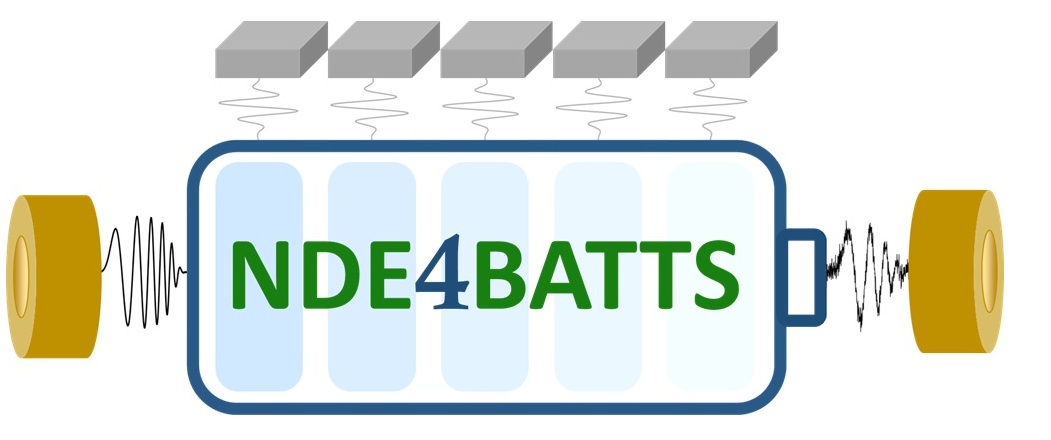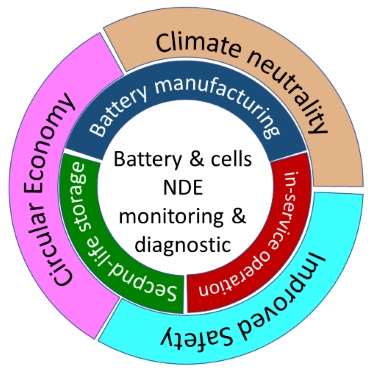
Title: Non-Destructive Evaluation for Improving Batteries Operation, Safety, and Second-Life
Acronym: NDE4BATTS
Project type: Project PRIN PNRR 2022 founded by MUR-EU; Starting year 2023
Principal Investigator: Marco Laracca
Founder: Missione 4 “Istruzione e Ricerca” - Componente C2 Investimento 1.1
“Fondo per il Programma Nazionale di Ricerca e Progetti di Rilevante Interesse Nazionale (PRIN)” Decreto Direttoriale n. 1409 del 14 settembre 2022 - Avviso pubblico per la presentazione di Progetti di ricerca di Rilevante Interesse Nazionale (PRIN) da finanziare nell’ambito del PNRR
PRIN 2022 P2022R9WT8 - CUP MASTER B53D23024080001 - CUP B53D23024080001
Financed amount: 237885,00 €
Partners:
- Department of Astronautics, Electrical and Energy Engineering, SAPIENZA University of Rome
- Department of Computer Engineering Modeling Electronics and Systems, University of Calabria
Goal

Global warming and the high-level of pollution in urban areas are leading to thorough changes in several sectors in the next years.
The EU aims at reaching climate neutrality in Europe by 2050 and the energy and mobility sectors should achieve Greenhouse gases neutrality even before. Electric Vehicles (EVs) are recognized as a clean technology that will significantly contribute to meet this
goal. Lithium-ion batteries (LIBs) are the dominant energy storage medium in EVs and battery EVs (BEVs) are expected to dominate the market in the next years. The accurate real-time monitoring of the battery state, especially of the State of Charge (SOC) and State of Health (SOH), is beneficial to ensure the safe, reliable, and efficient operation of the vehicles. In addition, it is also crucial in light of reusing the batteries for other less demanding applications, i.e. the batteries' second-life in a circular economy context. However, the non-linear dynamics of LIBs’ make the real-time estimate of SOC and SOH very challenging. The methods currently in use on BEVs work mainly on the whole battery and not at the cell level and, also for this reason, are prone to errors and low effectiveness. Further, they do not provide information about the possible inset of safety issues, which is monitored by measuring the temperature of the cell/battery and other parameters.
Developing more accurate and efficient methods to evaluate SOC and SOH and to detect early failure is thus a crucial goal to help a faster transition of the mobility sector to clean solutions while maintaining a high level of safety and comfort for the users.
Nondestructive evaluation (NDE) techniques have recently shown potential to innovate this scenario, and preliminary results have been reported in the literature. Both the SOC and SOH at the cell level can be accurately estimated by NDE analysis using eddy-current and ultrasonic sensors, as well as early signatures of failures can be detected.
NDE4BATTS focuses on this topic and brings together a multidisciplinary team to develop new NDE applications for the real-time monitoring of LIBs, also thanks to the support of companies and international research groups (see letters attached). Eddy-current and ultrasonic sensors will be installed on pouch cells, and the analysis will be done over charge-discharge cycles to study how the cell response modifies with time. Signal processing will be used to enhance the NDE sensitivity and accuracy, and to help the miniaturization of the sensors. Data analysis, supported by modelling of the chemical properties of the cell, will select the best features to be used for SOC and SOH estimation and to monitor failures. A comparison with state-of-the art methods will also be done.
Results

The main outcomes of NDE4BATTS will be new NDE methods/sensors/procedures/models for LIBs’ state estimation. These outcomes can be exploited to generate further research, in particular to increase the TRL level of the findings, and to produce and promote patenting, spin-off and other technology-transfer and entrepreneurship initiatives.
As said, the decision to commercially exploit the NDE4BATTS results will be thoroughly evaluated, and the last project Milestone - Innovation assessment and final report - will draw guidelines for this. It has also been demonstrated, that the techniques to be investigated and optimized in the project can be applied to other battery types, so the NDE4BATTS can serve as a starting point for research in this direction.
